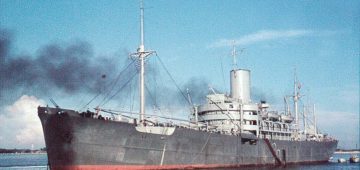by Richard Williams
Cadet training ships had been plying the oceans for many decades. In the British Merchant Navy such ships were owned by cargo/passenger companies as outlined in the detailed account written by Norman Middlemiss on this subject. This article is concerned with the training of deck cadets aboard one ship, Opalia.
In the early nineteen seventies concern was being felt in Shell Tankers (UK) Ltd. at the ever dropping success rate of cadets attaining their certificates of competency at the conclusion of their training, this despite the enlightened education regime in vogue at the time. Cadets attended nautical colleges prior, during and post qualifying sea time. This was in stark contrast to the rudimentary grooming afforded previous generations. Notwithstanding, there appeared to be a diminution in professionalism which if unchecked would give rise to lowered standards.
Thus the concept of Opalia developed, very much the brain child of a young, charismatic Chief Officer John L. Gyles who, almost singlehanded, evolved the project. John was one of a new breed of officers who obtained university degrees in addition to the standard nautical qualifications. The enlightened Shell management decided to proceed with a creation of a training ship of an entirely different ilk.

Opalia was chosen. A mid size steam turbine vessel of 52,800 tons deadweight with all aft accommodation An inspired choice, with ample space for the construction of lecture and training functions plus liberal room for eating and recreation facilities. The conversion was carried out in Hamburg during the latter part of 1974. The cabin configuration was amended to accommodate 28 cadets, separated from crew members from the engine room and catering departments. A large mess room provided ample seating for all cadets, additionally they were conferred the privilege of operating their own bar in a lounge explicitly for their own use. The refurbishment provided a fully equipped classroom, a study and technical library plus a seamanship workshop for practical instruction. Other features included an area of the Boat Deck, adjacent to the swimming pool, netted off for ball games and boxing. The Fo’cas’le housed two 14 feet Wayfarer sailing dinghies plus a small fleet of kayaks.
Opalia was mandated to be fully commercial without exception. From her inception she fulfilled this requirement. This quelled any doubts or cynicism that the venture evoked within and without Shell Tankers, and there were some! The staffing on Opalia’s initial voyage and subsequently, had in addition to the normal complement of officers and petty officers, an Instructor Chief Officer and an Instructor Chief Petty Officer plus a Safety Officer. The overarching ethos was that we taught by example, this being the guiding principle that was followed throughout, be it in tanker operation, safety, navigation and personal rectitude.

The cadet body consisted of 12 Phase Two cadets and 16 Initial Phase cadets (hereafter referred to as P2’s and ISP’s). P2’s possessed both Efficient Deck Hand and Lifeboat certificates, constituting the basic legal requirement. The Deck Department was manned solely by cadets without assistance from older ratings.
The training regime was thus: At sea, two P2’s would operate a tandem navigational process alongside the watch officer, navigating, making log book entries, tracking traffic and making observations. During the watch period one P2 navigated whilst the other maintained a look-out, changing function as arranged. Deck maintenance was carried out by ISP’s under tutelage of P2 supervisors.
The Instructor Chief Officer conducted an imaginative series of lectures, tests and open discussions with cadets, aimed at enhancing their knowledge of subjects required for their Second Mate’s ticket. The Instructor Petty Officer schooled the cadets in practical seamanship, rope and wire work, together with rigging etc.
Opalia, as a CTS, sailed from Hamburg in November 1974 under the command of Commodore Robert Lumsden. The fact that the Commodore was appointed to the ship indicated the importance with which management judged the venture. As indicated, Opalia was expected to meet all her commercial and operational objectives, she was nevertheless, a ‘personnel’ ship. The eyes of the fleet and those of the Department of Trade were upon her. The power behind the throne was of course the then Instructor Chief Officer John Gyles who carefully nurtured his project in its early days.
I was honoured to relieve Bob Lumsden at Dakar at the end of January 1975. He and I shared the command of this fine ship for the next two years, and in my time two hundred cadets received the benefit of the training. It is worth mentioning that a number of these young gentlemen are now in prominent managerial positions within the shipping industry – they have written to me!
On taking command I took the ship to Shellhaven whereupon we had an open day for Management and parents, of which more than fifty joined in the celebration. Thereafter, the Deputy Chief Examiner of Masters and Mates, Captain A. M. Jestico came aboard to carry out a voyage of inspection with a view to grant accreditation to Opalia as a cadet training ship. This was granted with the added bonus of reduced qualifying sea time for service served aboard Opalia.

At the end of my service aboard Opalia I was invited together with my wife to rejoin the ship as a guest, to be present at Her Majesty’s Jubilee Review of the Fleet. It made everything so worthwhile when we received the cryptic signal “Very Smart” from Admiral Sir Henry Leach, KCB, C in C Fleet, one of only two commendations of the whole Review.



Comments
Sorry, comments are closed for this item